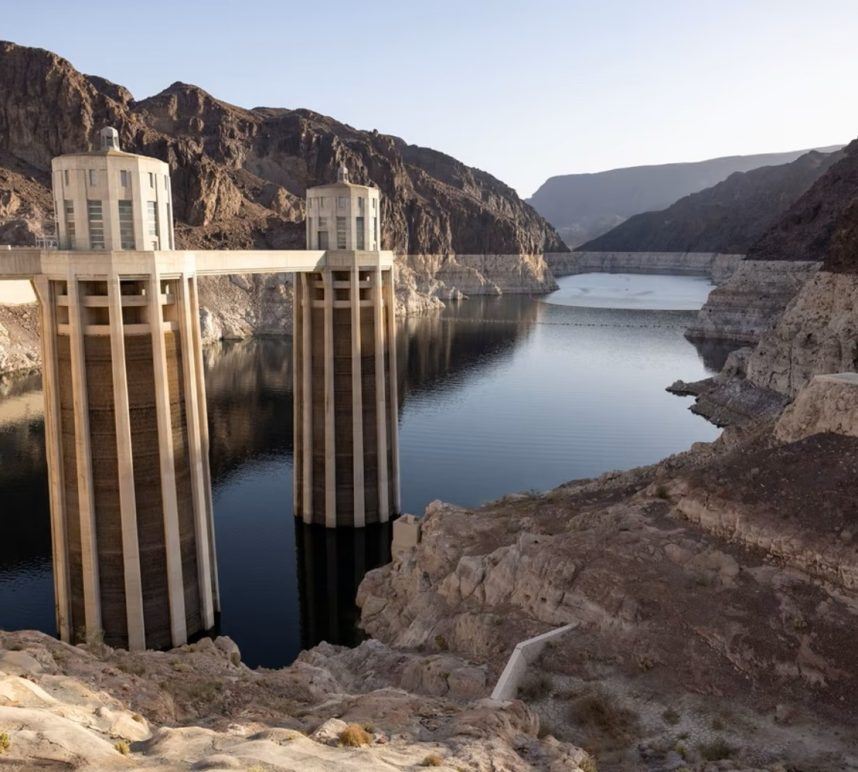Lake Mead-Size Water Loss From Colorado River Caused by Humans — Study
Posted on: July 26, 2023, 08:27h.
Last updated on: July 26, 2023, 12:47h.
From 2000 to 2021, human-caused climate change resulted in the loss of more than 10 trillion gallons of water from the Colorado River Basin — about equal to the entire storage capacity of Lake Mead — according to a new study modeling humans’ impact on hydrology in the drought-stricken region.

The study, led by UCLA and published in the journal Water Resources Research, is the first to quantify the rapid rate of runoff reduction and to prove its cause.
While we knew warming was having an impact on the Colorado Basin’s water availability, we were surprised to find how sensitive the basin is to warming compared to other major basins across the western U.S., and how high this sensitivity is in the relatively small area of the basin’s crucial snowpack regions,” said UCLA hydrologic modeler Benjamin Bass, lead author of the study. “The fact that warming removed as much water from the basin as the size of Lake Mead itself during the recent megadrought is a wakeup call to the climate change impacts we are living today.”
Without climate change, the drought in the basin most likely would not have reduced reservoir levels to the point of requiring supply cuts in 2021. That was determined under the first federally declared water shortage, according to the study. In May, Nevada, California, and Arizona agreed to cuts through 2026. The US government is expected to approve the cuts by August.

The Colorado River Basin covers about 250K square miles in seven states across the Western US and supplies water to about 40 million people, as well as supports agriculture and natural ecosystems. The regional drought that began in about 2000 is the driest period in 1,200 years, and has reduced river flow and shrunk reservoirs, increasing concerns about water scarcity as the climate continues to change.
Previous analyses of changing water resources in this region have focused on the effects of climate processes alone, without considering the impact of plants’ complex responses to increased atmospheric carbon dioxide.
The new study improves on previous hydrologic modeling of this region by including changes in runoff as a result of carbon dioxide-driven shifts in vegetation. It’s the first to calculate how much runoff changes per degree of warming based on historical warming in the Colorado River Basin’s snowpack regions. That’s as compared to non-snowpack regions, quantifying how climate change caused by humans has dried out traditional snowpack regions and rapidly reduced the runoff that feeds the Colorado River.
To see how the basin’s hydrology changed between 1880 and 2021, the researchers used a land surface model capable of analyzing water, changes in vegetation, and vegetation’s response to increasing atmospheric carbon dioxide. They used standard data sets to represent atmospheric conditions, streamflow gauges, and other records to capture the regional hydrology, and ground and satellite data to document actual changes in vegetation.
By including all these types of data, “we had all the major players in terms of runoff’s sensitivity to climate change,” Bass said.
Humans Raised Temp 2.7 Degrees
The model analyses showed that from 1880 to 2021, the temperature in the Colorado River Basin warmed about 2.7 degrees Fahrenheit as a result of climate change caused by humans. This warming has led to a 10.3% reduction in runoff under present-day conditions. Without including the effects of plants, present-day water loss would be closer to 13%, pointing to the importance of including vegetation processes in water modeling, the authors said.
That 10.3% decrease in runoff culminated during the historic drought of 2000 to 2021 when the cumulative volume of lost runoff water was approximately equal to the full capacity of Lake Mead, the largest reservoir on the Colorado River.
The researchers also discovered that the parts of the basin that are usually snow-covered in winter are now losing water about twice as fast as typically snowless regions. The transition is of immediate concern for water managers because snowpack makes an outsize contribution to the basin’s water supply: only about one-third of the basin is covered with snow each year. Those snowy regions are the source of about two-thirds of the basin’s total runoff.
The rapid water loss in snowpack regions is a sign the Rocky Mountain West is transitioning to a more arid climate rather than simply undergoing periodic droughts, according to Bass.
Bass pointed out that the 1922 Colorado River Compact, which governs the use of river water by the seven western US states in which the Colorado flows, was written with the assumption that the regional climate was stable.
When the representatives of these states signed the contract, “they expected 15 million acre-feet of water (about 4.6 million gallons) would be provided from the basin, on average, each year,” Bass said. “If they were outlining the compact now, they would need to adjust that value due to the impact of warming. Going into the future, we may get some natural variability, wet or dry swings. But this study highlights that there’s been a decreasing trend in runoff. In the long run, that’s likely to continue if greenhouse gas emissions are not reduced.”
Related News Articles
Colorado River Snowpack Reaches 158%, Easing Las Vegas Drought
VEGAS MYTHS BUSTED: Las Vegas Was Built on Barren Desert Terrain
Nevada, Southwest Faces Unprecedented Water Restrictions
Most Popular
FTC: Casino Resort Fees Must Be Included in Upfront Hotel Rates
Genovese Capo Sentenced for Illegal Gambling on Long Island
NBA Referees Expose Sports Betting Abuse Following Steve Kerr Meltdown
UPDATE: Former Resorts World & MGM Grand Prez Loses Gaming License
Most Commented
-
UPDATE: Whiskey Pete’s Casino Near Las Vegas Closes
— December 20, 2024 — 30 Comments -
Caesars Virginia in Danville Now Accepting Hotel Room Reservations
— November 27, 2024 — 9 Comments -
UPDATE: Former Resorts World & MGM Grand Prez Loses Gaming License
— December 19, 2024 — 8 Comments -
FTC: Casino Resort Fees Must Be Included in Upfront Hotel Rates
— December 17, 2024 — 7 Comments
















No comments yet